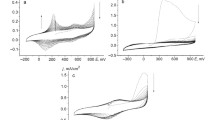Abstract
Polyacetylene films, contacted with platinum mesh, have been polarized anodically in aqueous H2SO4, HClO4, HBF4 and H2F2 of medium concentrations (30–70 wt%). Two oxidation peaks are observed, the equivalents of which are
The potential of the Process 1 decreases linearly with increasing acid concentration by 20–40 mV mol−1 dm−3, while the potential of Peak 2 exhibits normal Nernst behaviour (about + 60 mV decade−1. Process 1 is partially reversible, while Process 2 is totally irreversible. From these findings for Process 1 we conclude the reversible insertion of anions into the polyacetylene host lattice, which is primarily oxidized to the polyradical cation, with the co-insertion of acid molecules HA to yield the insertion compound [(CH)+·yA−·vyHA] x y⩽4.5% andv=1.5 for H2SO4 and HClO4. In the course of Process 2, the polymer is irreversibly oxidized according to
As this process occurs to some extent even in the potential region of Process 1, a continuous degradation of the host lattice occurs upon cycling.
Similar content being viewed by others
References
C. K. Chiang, M. A. Druy, S. C. Gau, A. J. Heeger, E. J. Louis, A. G. McDiarmid, Y. W. Park and H. Shirakawa,J. Amer. Chem. Soc. 100 (1978) 1013.
A. G. McDiarmid and A. J. Heeger,Synth. Metals 1 (1979/80) 101.
R. H. Baughman, S. L. Hsu, G. P. Pez and A. J. Signorelli,J. Chem. Phys. 68 (1978) 5405.
M. Monkenbusch, B. S. Morra and G. Wegner,Makromol. Chem. Rapid Commun. 3 (1982) 69.
S. R. Henning,Prog. Inorg. Chem. 1 (1959) 125.
L. B. Ebert,Ann. Rev. Mater. Sci. 6 (1976) 181. (Especially p. 196).
P. J. Nigrey, A. G. McDiarmid and A. J. Heeger,J. Chem. Soc. Chem. Commun. (1979) 594.
Idem, ibid. (1981) 317.
P. J. Nigrey, D. McInnes, D. P. Nairns, A. G. McDiarmid and A. J. Heeger,J. Electrochem. Soc. 128 (1981) 1651.
A. G. McDiarmid, A. J. Heeger and P. J. Nigrey, European Patent 36 118 (1981).
H. Shirakawa and S. Ikeda,Polym. J. 2 (1971) 231.
Idem, J. Polym. Chem. Ed. 12 (1974) 11.
J. Hocker, W. Wieder and R. Dhein, European Patent 45 908 (1981).
R. T. Gray, European Patent 50 441 (1981).
R. B. Kaner, A. G. McDiarmid and R. J. Mammone, ACS Symposium Series ‘Polymers in Electronics’, Washington 1984.
A. Guiseppi-Elie and G. E. Wnek,J. Chem. Soc. Chem. Commun. (1983) 63.
F. Beck, H. Junge and H. Krohn,Electrochim. Acta 26 (1981) 799.
Idem, Ber. Bunsenges. Phys. Chem. 86 (1982) 704.
F. Beck and H. Krohn, Proceedings of the Symposium ‘Electrochemistry of Carbon’, Cleveland 17–19 August 1983 (Edited by E. Yeageret al.) The Electrochemical Society, Princeton, 1984.
F. Beck and A. Pruß,Electrochim. Acta 28 (1983) 1847.
Idem, J. Electroanal. Chem. 172 (1984) 281.
F. Beck, W. Kaiser and H. Krohn,Angew. Chem. Suppl. (1982) 57.
F. Beck and W. Kaiser, Unpublished results.
D. Nägele and R. Bittihn, ISE Meeting, September 1983, DECHEMA Monographien (1984).
E. Rhodes, ‘Power Sources’ (edited by D. H. Collins) Oxford (1967) p. 1.
H. Krohn, F. Beck and R. Herrmann,Chem. -Ing. Techn. 54 (1982) 530.
F. Will, Electrochemical Society Meeting, San Francisco, May 1983, Extended Abstract No. 554.
H. W. Salzberg and M. Leung,J. Org. Chem. 30 (1965) 2873.
L. Eberson,J. Amer. Chem. Soc. 89 (1967) 4669.
H. P. Boehm, M. Eckel and W. Scholz,Zh. Anorg. Allg. Chem. 353 (1967) 236.
K. Kaneto, M. Maxfield, D. P. Nairns, A. G. McDiarmid and A. J. Heeger,J. Chem. Soc. Farad. Trans. 1 78 (1982) 3417.
Author information
Authors and Affiliations
Rights and permissions
About this article
Cite this article
Dietz, K.H., Beck, F. Positive polyacetylene electrodes in aqueous electrolytes. J Appl Electrochem 15, 159–166 (1985). https://doi.org/10.1007/BF00620929
Received:
Issue Date:
DOI: https://doi.org/10.1007/BF00620929




